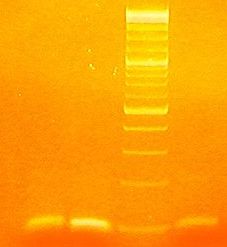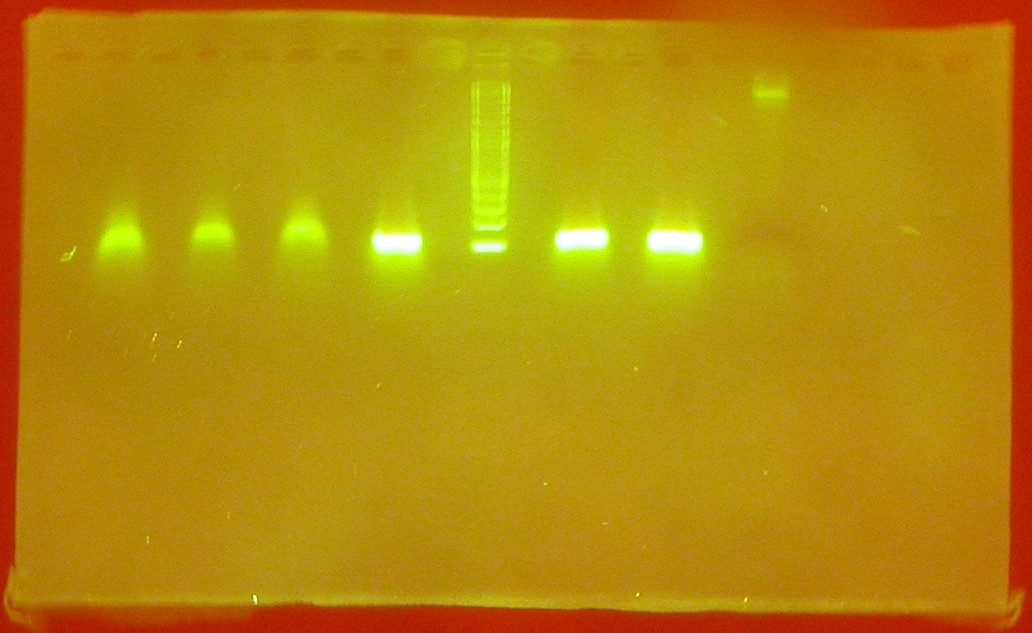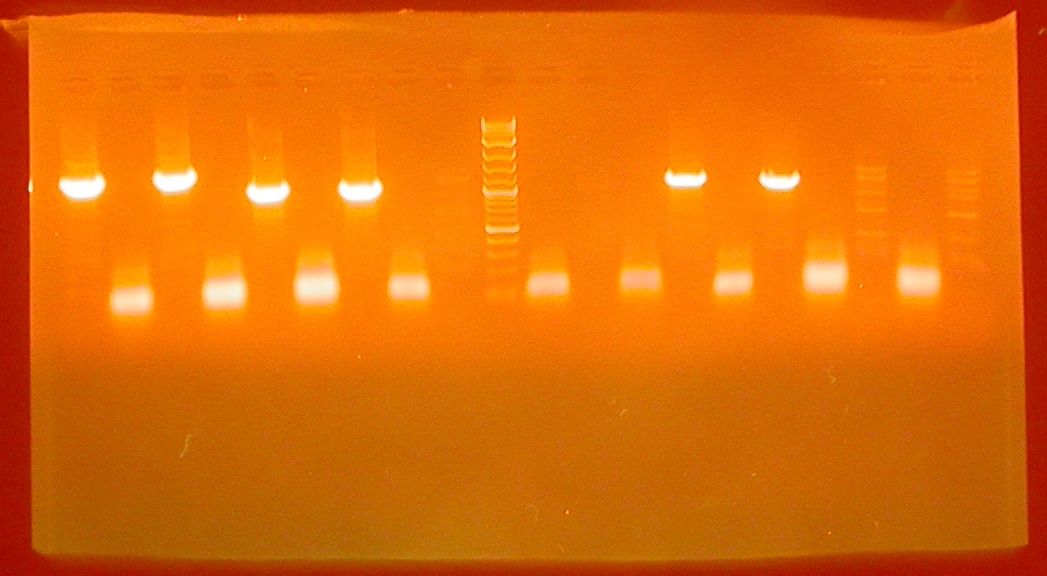Team:Bologna/Lab-Notebook
From 2009.igem.org
| Line 140: | Line 140: | ||
=Week 6: from 08/24/09 to 08/28/09= | =Week 6: from 08/24/09 to 08/28/09= | ||
| - | + | In order to confirm the promoter ratio we decide to study the different production of GFP without degradation tag (E0040) on PSB3K3 under J23100 (2547) and J23118 (1429) | |
| + | *Ligation of | ||
| + | # 2547_I13504 on PSB3K3 | ||
| + | # 1429_I13504 on PSB3K3 | ||
| + | # 2547_I13504 on PSB1A2 | ||
| + | # 1429_I13504 on PSB1A2 | ||
| + | *Transformation on DH5α chemically competent cells | ||
| + | *Control digestion checked on agarose gel | ||
| + | Experimental measures failed because GFP levels were too high to detect significant differences. We decided to use GFP with degradation tag (J04031 instead of E0040) | ||
<br> | <br> | ||
| - | * | + | *New annealing of CIS, TRANS_4 and TRANS_7 |
| - | + | *Purification from agarose gel of the annealed parts | |
| + | *X-P Digestion of: | ||
| + | # CIS | ||
| + | # TRANS_4 | ||
| + | # TRANS_7 | ||
| + | # PSB1AK3 | ||
| + | *Purification from agarose gel | ||
| + | *Ligation of CIS, TRANS_4 and TRANS_7 both on PSB1A2 and PSB4A3 | ||
| + | *Transformation on DH5α chemically competent cells | ||
| + | *We checked colonies with colony PCR, obtaining wrong MW bands | ||
[https://2009.igem.org/Team:Bologna/Lab-Notebook ''Up''] | [https://2009.igem.org/Team:Bologna/Lab-Notebook ''Up''] | ||
| + | |||
=Week 7: from 08/31/09 to 09/04/09= | =Week 7: from 08/31/09 to 09/04/09= | ||
| - | * | + | *Ligation of |
| - | * | + | # 1429_RBS_LacI_T on PSB1A2 |
| - | * | + | # 1429_RBS_LacI_T on PSB3K3 |
| + | *Transformation on DH5α chemically competent cells | ||
| + | *Control digestion checked on agarose gel | ||
<br> | <br> | ||
| - | [[Image:ColonyPCR_04_09cis_psb4a3_cis_psb3k3.JPG| | + | *New X-P digestion of CIS annealed and purified through agarose gel, increasing DNA quantity |
| + | *Ligation both on PSB4A3 and PSB3K3 | ||
| + | *Transformation on DH5α chemically competent cells | ||
| + | *We checked colonies with colony PCR | ||
| + | |||
| + | [[Image:ColonyPCR_04_09cis_psb4a3_cis_psb3k3.JPG|left|thumb|650px|PCR Colony: CIS on PSB4A3 in the first well, CIS on PSB3K3 in the others ]] | ||
| + | <br> | ||
| + | <br> | ||
| + | <br> | ||
| + | <br> | ||
| + | <br> | ||
| + | <br> | ||
| + | <br> | ||
| + | <br> | ||
| + | <br> | ||
| + | <br> | ||
| + | <br> | ||
| + | <br> | ||
| + | <br> | ||
| + | <br> | ||
| + | <br> | ||
| + | <br> | ||
| + | <br> | ||
| + | <br> | ||
| + | <br> | ||
| + | <br> | ||
| + | <br> | ||
| + | *Only one colony of ligation on PSB4A3 revealed correct MW band (about 300bp), but the plasmid isolated from this colony revealed wrong MW after control digestion checked on agarose gel | ||
<br> | <br> | ||
| - | * | + | *Same results were obtained for TRANS_4 and TRANS_7 parts: colony PCRs seemed right, but we found wrong MW bands after cheking on agarose gel. |
| - | + | ||
[https://2009.igem.org/Team:Bologna/Lab-Notebook ''Up''] | [https://2009.igem.org/Team:Bologna/Lab-Notebook ''Up''] | ||
| Line 162: | Line 208: | ||
=Week 8: from 09/07/09 to 09/11/09= | =Week 8: from 09/07/09 to 09/11/09= | ||
| - | * | + | * We received primers for our sequences and, after some tests, we made PCR of our 3 parts. (We used as primers standard prefix and suffix sequences). We made PCR both from annealed parts that from single strands, and we choose to extract the latter, because they presented low smears when checked on agarose gel. |
| - | + | ||
| - | + | ||
[[Image:10_09_PCR.JPG|center|thumb|580px|PCR of CIS-repressing and TRANS-repressor with primers]] | [[Image:10_09_PCR.JPG|center|thumb|580px|PCR of CIS-repressing and TRANS-repressor with primers]] | ||
| + | <br> | ||
| + | <br> | ||
| + | <br> | ||
| + | <br> | ||
| + | <br> | ||
| + | <br> | ||
| + | <br> | ||
| + | <br> | ||
| + | <br> | ||
| + | <br> | ||
| + | <br> | ||
| + | <br> | ||
| + | <br> | ||
<br> | <br> | ||
* We assumed that some of our ligation problems may be caused by the low enzymes efficiency because of the restriction sites were too near to the extremities of our sequeces. For that reason we decided to order longer primers in order to make our sequences longer and solve problems with enzymes. | * We assumed that some of our ligation problems may be caused by the low enzymes efficiency because of the restriction sites were too near to the extremities of our sequeces. For that reason we decided to order longer primers in order to make our sequences longer and solve problems with enzymes. | ||
| Line 171: | Line 228: | ||
| + | |||
| + | |||
| + | In order to analyse the high/low copy number plasmid ratio we decide to study the production of GFP without degradation tag on both PSB1A2 and PSB3K3 | ||
| + | [https://2009.igem.org/Team:Bologna/Lab-Notebook ''Up''] | ||
[https://2009.igem.org/Team:Bologna/Lab-Notebook ''Up''] | [https://2009.igem.org/Team:Bologna/Lab-Notebook ''Up''] | ||
Revision as of 15:51, 20 October 2009
| HOME | TEAM | PROJECT | SOFTWARE | MODELING | WET LAB | PARTS | HUMAN PRACTICE | JUDGING CRITERIA |
|---|
Week 1: from 07/20/09 to 07/24/09
- General Preparations:
- chemiocompetent cells from E. Coli DH5α, Top10 and DB 3.1
- antibiotic stocks of Ampicillin and Kanamicin
- LB medium and LB plates
- M9 medium
Week 2: from 07/27/09 to 07/31/09
In order to realize our projects, we started looking for stardard plasmids.
We needed one high and one low to medium copy number vectors, with different antibiotic resistence (A & K).
We searched the Registry and we decided two possible combinations: PSB1K3 with PSB4A3 or PSB1A2 with PSB3K3.
- Trasfomation of:
- PSB1A2 -> with BBa_J23100 and BBa_J04031 from our parts library
- PSB4A3 -> with BBa_J04500 and BBa_J04031 from our parts library
using Top10 chemically competent cells.
- Inoculation, miniprep preparation and control digestion, checked on agarose gel.
- Eluition and Trasfomation of:
- PSB1K3 -> from 2009 kit, with BBa_J04450
- PSB3K3 -> from 2009 kit, with BBa_J04450
using Top10 chemically competent cells.
Since neither PSB1K3 nor PSB3K3 yielded colonies we tried another transformation, choosing different kit wells.
- Eluition and Trasfomation of:
- PSB1K3 -> from 2009 kit, with BBa_P1010
- PSB3K3 -> from 2009 kit, with BBa_P1010
- PSB3K3 -> from 2007 kit, with BBa_P1010
using DB3.1 chemically competent cells.
- Inoculation, miniprep preparation and control digestion checked on agarose gel of PSB3K3 from 2007 kit.
(the only one that yielded colonies)
We decided to use PSB1A2 as high and PSB3K3 as low to medium copy number as they revealed right MW bands when checked with agarose gel. In the meantime, we requested another PSB1K3 with BBa_P1010 from Registry.
Up
Week 3: from 08/03/09 to 08/07/09
- Annealing of Cis-repressing (CIS) and Trans-repressor (TRANS_4 and TRANS_7)
- E-P Digestion of:
- CIS
- TRANS_4
- TRANS_7
- PSB1A2
| DNA sequences | Plasmid |
|---|---|
| H2O mQ == 4.5 μM | H2O mQ == 19.5 μM |
| Sequence == 20 μM | DNA (miniprep) == 5 μM |
| Buffer == 3 μM | Buffer == 3 μM |
| BSA == 0.5 μM | BSA == 0.5 μM |
| EcoRI enzyme == 1 μM | EcoRI enzyme == 1 μM |
| Pst1 enzyme == 1 μM | Pst1 enzyme == 1 μM |
| TOT: 30 μM | TOT: 30 μM |
- Purification from agarose gel
- Ligation of CIS, TRANS_4 and TRANS_7 on PSB1A2
- Transformation on DH5α chemically competent cells (-> few colonies)
- Inoculation and miniprep preparation
- Control digestion checked on agarose gel revealed wrong MW bands
- Ligation of:
- 2547_RBS_GFP_T on PSB1A2
- 1429_RBS_GFP_T on PSB1A2
- 2547_RBS_GFP_T on PSB3K3
- 1429_RBS_GFP_T on PSB3K3
- Transformation on DH5α chemically competent cells
- Control digestion checked on agarose gel
Week 4: from 08/10/09 to 08/14/09
HOLIDAY!!!
Up
Week 5: from 08/17/09 to 08/21/09
In order to analyse the CIS/TRANS production ratio of our project circuit, we made some measures, using GFP as reporter.
- Transformation of
- 1429_RBS_GFP_T on PSB3K3
- 2547_RBS_GFP_T on PSB1A2
- 1429_RBS_GFP_T on PSB3K3 + 2547_RBS_GFP_T on PSB1A2
We made another cloning attempt of CIS, TRANS_4 and TRANS_7
- X-P Digestion of:
- CIS
- TRANS_4
- TRANS_7
- PSB1A2
- PSB4A3
- Purification from agarose gel
- Ligation of CIS, TRANS_4 and TRANS_7 both on PSB1A2 and PSB4A3
- Transformation on DH5α chemically competent cells (-> few colonies)
- Inoculation and miniprep preparation
- Control digestion checked on agarose gel revealed wrong MW bands
Week 6: from 08/24/09 to 08/28/09
In order to confirm the promoter ratio we decide to study the different production of GFP without degradation tag (E0040) on PSB3K3 under J23100 (2547) and J23118 (1429)
- Ligation of
- 2547_I13504 on PSB3K3
- 1429_I13504 on PSB3K3
- 2547_I13504 on PSB1A2
- 1429_I13504 on PSB1A2
- Transformation on DH5α chemically competent cells
- Control digestion checked on agarose gel
Experimental measures failed because GFP levels were too high to detect significant differences. We decided to use GFP with degradation tag (J04031 instead of E0040)
- New annealing of CIS, TRANS_4 and TRANS_7
- Purification from agarose gel of the annealed parts
- X-P Digestion of:
- CIS
- TRANS_4
- TRANS_7
- PSB1AK3
- Purification from agarose gel
- Ligation of CIS, TRANS_4 and TRANS_7 both on PSB1A2 and PSB4A3
- Transformation on DH5α chemically competent cells
- We checked colonies with colony PCR, obtaining wrong MW bands
Week 7: from 08/31/09 to 09/04/09
- Ligation of
- 1429_RBS_LacI_T on PSB1A2
- 1429_RBS_LacI_T on PSB3K3
- Transformation on DH5α chemically competent cells
- Control digestion checked on agarose gel
- New X-P digestion of CIS annealed and purified through agarose gel, increasing DNA quantity
- Ligation both on PSB4A3 and PSB3K3
- Transformation on DH5α chemically competent cells
- We checked colonies with colony PCR
- Only one colony of ligation on PSB4A3 revealed correct MW band (about 300bp), but the plasmid isolated from this colony revealed wrong MW after control digestion checked on agarose gel
- Same results were obtained for TRANS_4 and TRANS_7 parts: colony PCRs seemed right, but we found wrong MW bands after cheking on agarose gel.
Week 8: from 09/07/09 to 09/11/09
- We received primers for our sequences and, after some tests, we made PCR of our 3 parts. (We used as primers standard prefix and suffix sequences). We made PCR both from annealed parts that from single strands, and we choose to extract the latter, because they presented low smears when checked on agarose gel.
- We assumed that some of our ligation problems may be caused by the low enzymes efficiency because of the restriction sites were too near to the extremities of our sequeces. For that reason we decided to order longer primers in order to make our sequences longer and solve problems with enzymes.
- Starting work with the operator Ox, developed by the 2008 Bologna Igem Team
In order to analyse the high/low copy number plasmid ratio we decide to study the production of GFP without degradation tag on both PSB1A2 and PSB3K3
Up
Up
Week 9: from 09/14/09 to 09/18/09
- Primers arrived, so we can use them to make our sequences longer.
- The operator OX was mounted on a standard plasmid.
- Tried a ligation with a plasmid containing the cell death gene, without positive results.
Week 10: from 09/21/09 to 09/25/09
- Performed other tests with CIS-repressing and TRANS-repressor.
- DNA-sequencing of the circuit with the operator OX, our first new BioBrick.
Week 11: from 09/28/09 to 10/02/09
- Ligation and mini-prep of the operator Ox, upstream of the protein GFP, under the control of the promoter J23118
- Digestion and ligation of Cis-repressing and Trans-repressor using the restriction enzymes SpeI and XbaI.
- Control digestion and Gel run; bur this test gave out only a strain, may be due to digestion problems.
Week 12: from 10/05/09 to 10/09/09
- Performed other tests mainly for perform fluorescence measures.
- Preparation of our BioBricks for the shipment.
 "
"




